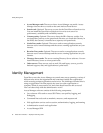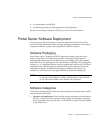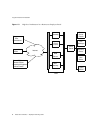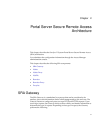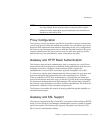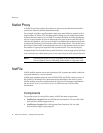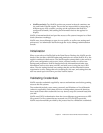SRA Gateway
38 Portal Server 6 2005Q1 • Deployment Planning Guide
• Netlet request. Routes the request (traffic) to the server specified in the Netlet
rule that the user clicked in the Portal Desktop.
• HTTP(S) traffic. Routes the request to the server as specified by the HTTP
header. Upon receiving a response from the server, the Gateway translates the
response so that all intranet links within the response work on the extranet.
All the Gateway configuration information is stored in the Access Manager’s
LDAP database as a profile. A gateway profile consists of all the configuration
information related to the Gateway except .
All machine-specific information, such as machine-specific information such as
host name and IP address, is stored in a configuration file in the local file system
where the Gateway is installed. This enables one gateway profile to be shared
between Gateways that are running on multiple machines.
As mentioned previously, you can configure the Gateway to run in both HTTP and
HTTPS modes, simultaneously. This helps both intranet and extranet users to
access the same Gateway: extranet users over HTTPS, and intranet users over
HTTP (without the overhead of SSL).
You can also run the Gateway in
chroot environments. See the Portal Server Secure
Remote Access 6 Administration Guide for more information.
Multiple Gateway Instances
If desired, you can run multiple Gateway instances on a single machine—this is
referred as a multihomed Gateway. Each Gateway instance listens on separate
port(s). You can configure Gateway instances to contact the same Portal Server
instance, or different Portal Server instances. When running multiple instances of a
Gateway on the same machine, you can associate an independent certificate
database with each instance of the Gateway, and bind that Gateway to a domain. In
essence, this provides the flexibility of having a different Gateway server certificate
for each domain.
Multiple Portal Server Instances
When you configure the Gateway with multiple instances of Portal Server, the
Gateway automatically performs round-robin load balancing by logging in users
with the different servers, alternately. The Gateway also keeps a list of active
servers to avoid trying to login users to an inactive server. This mechanism helps to
avoid single points of failure with Portal Server.



